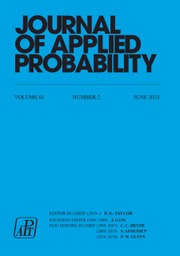Crossref Citations
This article has been cited by the following publications. This list is generated based on data provided by
Crossref.
Goldberg, Lisa R.
and
Mahmoud, Ola
2014.
On a Convex Measure of Drawdown Risk.
SSRN Electronic Journal,
Landriault, David
Li, Bin
and
Li, Shu
2015.
Analysis of a drawdown-based regime-switching Lévy insurance model.
Insurance: Mathematics and Economics,
Vol. 60,
Issue. ,
p.
98.
Mahmoud, Ola
2015.
The Two Dimensions of Drawdown: Magnitude and Duration.
SSRN Electronic Journal,
Landriault, David
Li, Bin
and
Li, Shu
2016.
Drawdown analysis for the renewal insurance risk process.
Scandinavian Actuarial Journal,
p.
1.
Cui, Zhenyu
2016.
Magnitude and Speed of Consecutive Market Crashes in a Diffusion Model.
SSRN Electronic Journal ,
Petrov, Vladimir
Golub, Anton
and
Olsen, Richard B.
2018.
Instantaneous Volatility Seasonality of Bitcoin in Directional-Change Intrinsic Time.
SSRN Electronic Journal ,
MÖLLER, PHILIPP M.
2018.
DRAWDOWN MEASURES AND RETURN MOMENTS.
International Journal of Theoretical and Applied Finance,
Vol. 21,
Issue. 07,
p.
1850042.
Landriault, David
Li, Bin
and
Li, Shu
2018.
Expected utility of the drawdown-based regime-switching risk model with state-dependent termination.
Insurance: Mathematics and Economics,
Vol. 79,
Issue. ,
p.
137.
Dassios, Angelos
and
Lim, Jia Wei
2019.
A variation of the Azéma martingale and drawdown options.
Mathematical Finance,
Vol. 29,
Issue. 4,
p.
1116.
Petrov, Vladimir
Golub, Anton
and
Olsen, Richard
2019.
Instantaneous Volatility Seasonality of High-Frequency Markets in Directional-Change Intrinsic Time.
Journal of Risk and Financial Management,
Vol. 12,
Issue. 2,
p.
54.
Wang, Wenyuan
Chen, Ping
and
Li, Shuanming
2020.
Generalized expected discounted penalty function at general drawdown for Lévy risk processes.
Insurance: Mathematics and Economics,
Vol. 91,
Issue. ,
p.
12.
Brinker, Leonie Violetta
2021.
Minimal Expected Time in Drawdown through Investment for an Insurance Diffusion Model.
Risks,
Vol. 9,
Issue. 1,
p.
17.
Geboers, Hans
Depaire, Benoît
and
Annaert, Jan
2023.
A review on drawdown risk measures and their implications for risk management.
Journal of Economic Surveys,
Vol. 37,
Issue. 3,
p.
865.
Zabarankin, Michael
Grechuk, Bogdan
and
Hao, Dawei
2024.
Benchmark-based deviation and drawdown measures in portfolio optimization.
Optimization Letters,
Vol. 18,
Issue. 7,
p.
1561.
Salcı‐Bilici, M.
Erdem, F. Pınar
Ünalmış, İbrahim
and
Vardar‐Acar, C.
2024.
Has the Last Super Cycle in Crude Oil Price Ended? a Maximum Drawdown Approach Using Fractional Brownian Motion.
Applied Stochastic Models in Business and Industry,
Proietti, Tommaso
2024.
Ups and (Draw)Downs.
SSRN Electronic Journal,
Doeswijk, Ronald
and
Swinkels, Laurens
2026.
The risk and reward of investing.
Journal of International Money and Finance,
Vol. 160,
Issue. ,
p.
103453.

